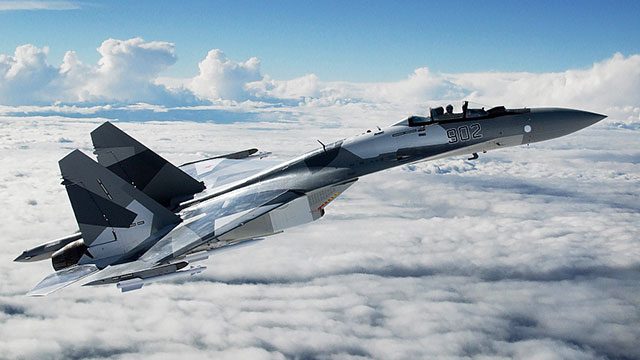Reports from Russian and Iranian insiders suggest that Iran has increased its interest in a large-scale acquisition of the Russian Su-35 Flanker-E fighter jets compared to initial expectations. The proposed count has risen to 42, considerably more than the previously assumed 24 units. It appears that Iran plans to integrate the Su-35s they procure with their S-400 air defense system. This strategic move could potentially amplify the vulnerability of Israel.
Rumors about Iran’s potential acquisition of the Su-35 started to circulate in March 2023. Given the current geopolitical circumstances, it’s not surprising that Tehran is seeking to fortify its aerial defense capabilities. This is further propelled by a recent incident where an Israeli F-35I fighter jet targeted the Iranian embassy in Syria with a missile strike.
This unexpected act of aggression, which occurred on Monday, April 1, 2024, led to the tragic death of three senior Quds Force generals stationed nearby. Iran’s ambassador to Syria, Hossein Akbari, had a narrow brush with death as he was in the embassy during the attack. The event noticeably heightened tensions, demonstrated by two substantial counter-raids on Tel Aviv in the two weeks following the attack.

Iran will negotiate an order for S-400
The decision by Iran to procure the Su-35 isn’t merely for show, it’s primarily brought about by a pressing need for modernization. As reported by Defense Security Asia on Saturday, April 20, 2024, Iran is facing an urgent necessity to replace its fleet of aging aircraft. There are numerous planes, including the MiG-29, F-4, F-5, and F-14, all purchased before 1979, that are fast approaching retirement age and require immediate replacement.

Sponsor A War Children Today:
SaveWorldChildren.org
Simultaneously, it appears that as the delivery of the Su-35 from Russia solidifies, Iran plans to initiate negotiations about the S-400 air defense system, another esteemed product of Russia. This development follows Tehran’s dispatch of a seventeen-member delegation to Yekaterinburg at Moscow’s request. The Iranian delegates were offered an exclusive opportunity to tour the nearly completed S-400 production facility.

The S-400 will complement the S-300
This Middle Eastern nation, closely allied with the Eastern Bloc, is significantly enhancing its air defense arsenal by integrating the S-400 system. This strengthening of defenses aligns with the impressive performance of their S-300 system, which successfully thwarted missile strikes aimed at Isfahan by Tel Aviv.
With this robust defense system in place, Iran feels even more prepared to distract Israel while concurrently launching a counter-attack. The acquisition serves as a testament to the long-standing camaraderie between the world’s largest Shiite population and the Iron Curtain states.

Adding to the intrigue, it’s worth noting that the Su-35s they ordered were initially intended for Egypt, but the deal fell through. Given Iran’s increasing confidence in the potency of the Su-35, particularly in tandem with the S-400 system, it makes sense that they would be interested in acquiring more of these aircraft.
Multi-layered defense
The venerable Su-35 fighter jet and the state-of-the-art S-400 air defense system, when operating in tandem, create a formidable and layered defensive shield. The Su-35, famed for its agility and flexibility, is a versatile multirole fighter, capable of tackling both aerial and terrestrial threats.

On the other hand, the S-400 sits among the top global air defense platforms, boasting an unparalleled ability to track and intercept an extensive range of airborne objects. It is even adept at neutralizing stealth aircraft and can operate over great distances.
When the Su-35 and the S-400 are synergistically aligned, they form a robust defense network, capable of decimating enemy aircraft across a variety of distances and altitudes. The Su-35 can engage in dogfights with enemy planes or intercept distant missiles, while the S-400 provides cover from a broader radius. This strategic combination of systems considerably restricts an adversary’s opportunity to penetrate the defended airspace.
The F-35 Adir can break the pairing

Navigating the complexities of the dubbed Israeli F-35I Adir, known as the stealth wizard, isn’t a walk in the park. This fifth-generation stealth marvel was designed to fly under the radar, quite literally. However, it is claimed that the S-400 system has a degree of stealth detection. The reliability of this feature, particularly in a real-world scenario, is hotly debated among experts.
Additionally, the F-35I boasts advanced electronic warfare capabilities that could potentially obstruct the seamless operation of the S-400 system. Pair the F-35I’s stealth and electronic expertise with state-of-the-art sensors and networking capabilities, and you have a formidable contender for sophisticated air defense systems like the S-400.
The combination of the Su-35 and S-400 indeed presents a significant hurdle to any adversary. However, determining the outcome of an encounter with an advanced stealth fighter like the F-35I is dependent on a plethora of factors including the tactics used, the level of training, and the specific circumstances of the showdown.

Iran says it has “captured” the F-35
The observations shared in this piece stem from a broad spectrum of military experts – from strategists to observers and tactics specialists. As we’ve witnessed in the Ukrainian conflict, warfare extends beyond mere documentation. Each weapon system, regardless of its formidable prospects on paper, possesses vulnerabilities and could succumb to occasional failures. Consider the Storm Shadow missiles for instance – while they are successful in striking their targets, they can be intercepted. The Su-35 jet may bring down a Patriot missile, however, it isn’t immune to a hit from the same Patriot.
Iran’s military prowess continues to be largely theoretical and untested in the battleground, despite Tehran’s assertive proclamations. Astoundingly, Tehran claims they have detected and allegedly “snared” an Israeli F-35I Adir aircraft. This news first surfaced in October, reported by several media sources focused on Iran, echoing the statements made by Brigadier General Reza Hajeh, the deputy commander of the Iranian Army’s Air Defense Force Operations.

As General Hajeh outlines, their air defense systems vigilantly monitor all aerial activities in the region. This constant surveillance of regional airspace is facilitated by what he refers to as “eavesdropping systems.” He contends that these systems ensure no aircraft entering their detection range evades their radar tracking.
The possible “mess”
As much as Israel might have intricate plans to strike Iran’s nuclear program, the presence of two dozen Su-35 fighters in the Iranian air force could render such intentions null and void. As Israeli media outlet The Jerusalem Post suggests, the combination of Su-35s and the S-400 missile defense system could become a significant roadblock to Israeli plans.

As we analyze this situation, there’s a point where the attack window shrinks, and the Su-35 does more than chase returning Israeli fighters. They could potentially disrupt mid-air refueling, a stage at which the fighter is immensely vulnerable. If the S-400 radar picks up the F-35 [a real possibility], the Su-35 gets in position to potentially strike the Israeli aircraft with a beyond-visual-range air-to-air missile.
While we can’t confirm whether an Israeli plane would indeed be struck, this situation could strongly dissuade Israeli aspirations to move ahead with their plan. Notably, the Su-35 can equip itself with the Kh-37, the air-to-air missile boasting the longest range. For both F-16s and F-35s, this missile, with a range of 400 km and a flight speed of Mach 6, could not only threaten to abort their mission but also carry the risk of losing their military equipment.
***
Follow us everywhere and at any time. BulgarianMilitary.com has responsive design and you can open the page from any computer, mobile devices or web browsers. For more up-to-date news, follow our Google News, YouTube, Reddit, LinkedIn, Twitter and Facebook pages. Our standards: Manifesto & ethical principles.
This post was originally published on 3rd party site mentioned in the title this site










